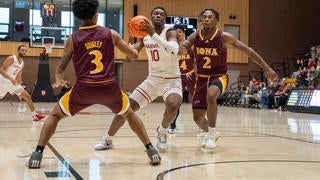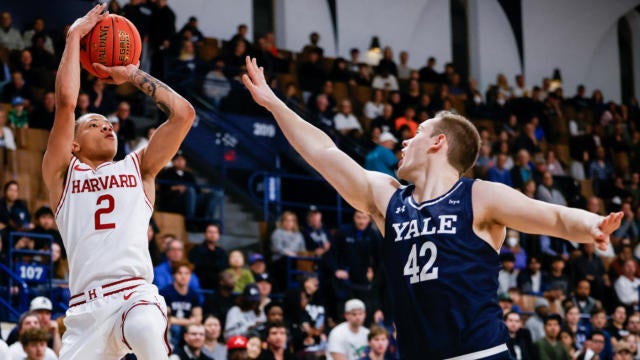College basketball's transfer trends are now touching the last sacred corner of Division I athletics: the Ivy League has officially become a stepping stone for basketball prospects en route to an NIL payday.
Harvard forward Chisom Okpara's entry into the transfer portal on Tuesday is just the latest evidence of the trend, which has taken hold in the 2024 transfer cycle with players such as Malik Mack (Harvard to Georgetown) Danny Wolf (Yale to Michigan), Tyler Perkins (Penn to Villanova) and Kalu Anya (Brown to Saint Louis).
Does a two-year NIL earnings window outweigh the lifelong benefits of graduating from Harvard? That's debatable. But even the Ivy League and its fabled group of academically superior institutions is not immune to the roster poaching that is now the norm in college basketball.
As a 6-foot-8 stretch forward who averaged 16.5 points for the Crimson in his sophomore season, Okpara has enough game to play at the high-major level. Two years from now, it's possible his degree could be from a state university with an acceptance rate of 85% instead of from Harvard. But he'll profit off his talents in a way that he can't at Harvard, which does not have an NIL collective.

Outbound Ivy League transfers are nothing new in men's basketball. A steady stream of them have made their way to new homes in the sport over the last several years. But that has typically been because the league's rules not only don't allow athletic scholarships, but also prohibit graduate students from competing. Thus, some players wanting to use their final season(s) of eligibility had no choice but to leave the conference.
The same thing is occurring this year with Clark Slajchert (Penn to USC), Chris Manon (Cornell to Vanderbilt), Matt Knowling (Yale to USC), Justice Ajogbor (Harvard to Saint Joseph's), Matt Allocco (Princeton to Notre Dame) and other graduate transfers.
But as those players depart the Ivy League, they are doing so with immensely valuable degrees from the nation's most prestigious schools.
Mack, Wolf, Perkins, Anya and Okpara are leaving with some credit hours and a big bet on their athletic futures. They are wagering that the money they earn and basketball development they receive at new institutions will ultimately prove more valuable than lifelong status as an Ivy League graduate.
They were smart enough to be admitted to Ivy League schools in the first place. So it's safe to assume they made sound decisions after thoroughly evaluating the pros and cons of each side. Only time will tell whether they were right decisions, but they are decisions with ramifications for college basketball and the Ivy League.
In the short run, the trend of undergraduate stars transferring out is a disaster for Ivy League coaches and programs. Where is Harvard coach Tommy Amaker going to find suitable replacements for Mack and Okpara, who were his two leading scorers in the 2023-24 season?
Even if there were an abundance of uncommitted players from the Class 2024 available, Harvard's 3.6% acceptance rate would eliminate nearly all of them, and the application deadline for admission has long passed. The university's transfer acceptance rate is even lower. Harvard's website notes that it welcomes about 12 transfers each fall from a pool that averages more than 1,500 applicants.
Amaker can't exactly go mining the America East or NEC for reinforcements. Seven players with somewhat significant game experience are set to return for Harvard, but none of them averaged double figures. Amaker may wind up relying on a four-man freshman signing class to offer substantive contributions next season.
In the long run, perhaps this transfer cycle is a good thing for the Ivy League programs. It could be the impetus to awakening a dormant sense of competitive drive within a class of immensely wealthy alumni who have the power to bring change.
Certainly, graduates of schools such as Harvard, Princeton and Yale have more important philanthropic causes at hand than retaining all-conference basketball players. But they also have no shortage of money to throw around. Brown was the only Ivy League school that did not appear on Forbes' 2022 list of 11 universities with the wealthiest alums.
With the pocket change those alums have left over after donating to more pressing causes, they could band together to build their basketball programs into formidable powers. However, the concept of collectives has been met with both institutional and alumni resistance in the Ivy League, as the Harvard Crimson recently reported.
The idea behind the hesitance is that the Ivy League experience is about academics first. If you're paying the basketball players for their talents, then why aren't you also paying the future doctors, future technology gurus and future world leaders who are also enrolled? The degree is your compensation. It's the key to get you in doors that most can never enter.
But if high-level Ivy League basketball players continue to denigrate the value of Ivy League degrees by choosing to play at other universities, eventually pride will become a factor.
Even a single sports-obsessed donor could singlehandedly launch an annual fund with enough money to keep players like Mack and Okpara at Harvard. A handful of athletically-minded donors from an Ivy League school could pool their donations and create the spending power needed to turn their alma mater into the league's dominant force.
The only constant in college sports is change, and perhaps the 2024 college basketball transfer cycle will be the spark that brings some of that change to the Ivy League's approach on NIL.
If not, then expect to see more and more undergraduate basketball players leaving the nation's most prestigious academic institutions in the years ahead.

